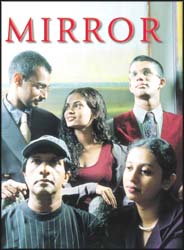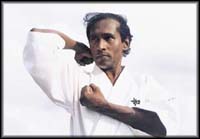 |
 26th September 1999 |
Front Page| |
 |
Contents | |
 |
Continuing Udena R.Attygalle's series on martial artsKarate
But nothing could be further from the truth. Bruce Lee practised Kung Fu and then invented his own fighting method called Jeet Kune do. Besides every movement in karate begins with a defensive action, underlining its defensive nature. Karate (Karate-do in Japanese) literally means 'empty hand' or 'empty hand way'. Although primarily a system of unarmed combat, it is an excellent method of achieving physical fitness and mental discipline. Karate movements can look odd to the layman but each movement is based on sound, psychological principles perfected through years of study. Karate is thought to have originated from a martial art developed in Okinawa, an island north of mainland Japan. The Okinawan martial arts were heavily influenced by the Chinese martial arts. Incidentally, for those interested "The History of Karate-do" by Douglas Peries provides a detailed account of Karate history in Sinhala. Although there are many styles of Karate: developed with each generation of Senseis , the four styles recognized internationally at present are Shotokan, Goju-Ryu, Wado-Ryu and Shito-Ryu. While Shotokan has developed mainly into a sport, the other three styles retain their martial arts aspects.( Take a keen look at the many martial arts posters pasted on the city walls and you will discover many of the styles). Douglas Peries, a Wado-Ryu teacher believes that the fighting aspect of Karate is a mere drop in the ocean. "The art of Karate runs much deeper than mere fighting," he says. The spectacular feats like breaking stones, Mr. Peries believed were developed "to test the karateka's strength. Stone-breaking requires both technical skill ( i.e. bringing the hand down in a curve, relaxed at first and then tensed) and also inner strength. So don't try it at home no matter how easy it looks on TV. According to Mr Peries, inner power is generated in the abdomen by consciously compressing the abdominal cavity from both above and below. The power is then consciously transferred to the part of the body where it is needed. Kata and Kumite are the main forms of Karate. A Kata is a pattern of movements which contains a series of logical and practical blocking and attacking techniques. The true meaning and spirit of the art is embedded in these kata. Kata are practised alone, against imaginary opponents. The techniques in these kata have evolved from and been tested in actual combat. Each step of the kata needs to be analysed and understood before it can be applied to a real fight. Anton Charles, a champion karate fighter says, "a Kata artist is not effective in a real fight unless he learns to spar." Every kata begins with a defensive movement, in harmony with the non-attacking philosophy of Karate. To practise the kata correctly, the movements must be repeated over and over again.Only through constant repetition can the actions become reflex movements. And when kata is performed by a well trained Karateka, it is truly poetry in motion almost like ballet. "The kata stances and the breathing techniques involved in it also help improve blood circulation, massage internal organs and in general contribute a lot towards good health," Mr. Peries said, explaining how it helped one keep fit; physically and mentally. If kata is the 'theory' then kumite is the 'practical application' of the fighting methods. Kumite is the sparring aspect of Karate. In earlier times Kumite was actual fighting, but more recently, sparring was made possible with the blow being delivered just short of the opponent. But actually making contact with the opponent still takes place in some forms. Sparring itself is divided into two groups, free sparring and pre -arranged sparing .The former is when partners spar freely with each other. During sparring there must be mutual trust between the partners for even one misplaced strike is enough to cause a lot of pain and discomfort. Any attack that targets a vital point is forbidden. Pre-arranged sparring is when pairs of students are instructed to carry out clearly defined offensive or defensive techniques. This is designed to improve timing, rhythm and judgment of fighting distance. Free sparing is not encouraged until a Karate student has a firm grasp of the basics, a high level of fitness and has been practising pre-arranged sparring with good focus and control. If you are faced with an attack Karate provides three ways of avoiding getting hurt. You can either block the blow, avoid it by moving slightly. or you can break the attacker's hand using both his and your strength! Mr Peries demonstrated how little we need to move to avoid an attack. Karate is a more refined and peaceful art than many would believe. But then this refinement like road manners depends mostly on the individual.
Front Page| News/Comment| Editorial/Opinion| Business| Plus |Sports |
|
 |
Please send your comments and suggestions on this web site to |
|

 "Karate
ni senti nashi" means there is no first attack in Karate. Yet most
people brand Karate as an aggressive art. Wasn't Bruce Lee a Karateka?
And he was aggressive.
"Karate
ni senti nashi" means there is no first attack in Karate. Yet most
people brand Karate as an aggressive art. Wasn't Bruce Lee a Karateka?
And he was aggressive.